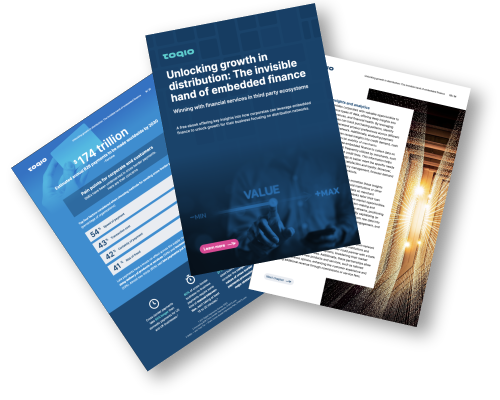Third sector insights: Optimizing cash disbursements for merchants

With the rise of embedded finance, businesses can now learn valuable lessons from non-profit organizations on optimizing cash disbursements for their merchant ecosystems. In a recent executive roundtable hosted by Toqio and Railsr, leaders from Mastercard, the United Nations and other industry players came together to discuss the challenges and opportunities of embedded finance in overcoming traditional cash distribution hurdles in the third sector. The discussion offered valuable insights on the complex environment that these third sector organizations must operate within on how embedded finance is unlocking new opportunities for them to deliver on their mission driven objectives., Mastercard's insights and data shared in the forum underscore the significant benefits and necessary precautions that come with embracing digital disbursement solutions, paving the way for a more efficient and secure future.
 |
 |
|
Mike Galvin |
Louisa Murray |
By
Mike Galvin, Chief Partnership Officer and Co-founder, Toqio
and
Louisa Murray, Chief Sales Officer, Railsr
In this blog post, we'll delve into how incorporating these discussion insights can help corporations streamline their cash management processes and drive greater value for both themselves and their merchant partners. Keep reading to learn more.
Making the case for B2B embedded finance
Governments, NGOs, and charities are shifting from reactive to proactive financial strategies, and are now actively seeking embedded finance platforms. This move signals a commitment to long-term, innovative solutions that leverage the evolving fintech landscape. We’re seeing this shift through large-scale RFPs, demonstrating a readiness to adopt new systems and improve financial operations.
– Simon Wright-Lakin, Mastercard
Third sector organizations, including civic and non-governmental organizations (NGOs), charities, and other non-profits, have struggled with securely and efficiently disbursing cash due to the complexities of regulated financial services. Traditionally reliant on physical cash, these entities have faced challenges made more acute by the shift towards digital services and contactless transactions, accelerated by the COVID-19 pandemic. This shift has highlighted the impracticality of physical cash.
For corporates, significant challenges in merchant cash disbursements often arise at the 'last mile out' in supply chains, particularly in remote areas with limited banking infrastructure. These regions pose risks like theft, fraud, and delays due to the complexities of handling physical cash. Ensuring timely and accurate payments is also complicated by inadequate identification and financial documentation, leading to inefficiencies and potentially disrupting supply chains.
The digital revolution in the last decade has paved the way for the wide-scale adoption of digital technologies, particularly in remote areas, as they offer lower transaction costs and enhance efficiency by providing real-time payments 24/7. Moreover, these solutions are expected to increase digital remittances by USD 20 billion by 2026 in Latin America alone due to the region’s high mobile and internet penetration.
Embedded finance further revolutionizes this space by integrating financial services such as payments directly into organizational operations, thus streamlining fund distribution and ensuring compliance. While this concept has been primarily embraced by the tech sector, there are valuable lessons that can be learned from the third sector, specifically the non-profit and charitable organizations.
Here are a few ways that corporations can improve their merchant cash disbursements using embedded finance, based on the practices of the third sector:
Streamlining the disbursement process
One of the main lessons that can be learned from the third sector is the importance of streamlining the disbursement process. Non-profit organizations often have limited resources and tight budgets, making it crucial for them to find efficient ways to distribute funds to their beneficiaries. By leveraging embedded finance, corporations can also simplify and accelerate their disbursements, reducing the administrative burden and improving their overall financial management. Embedded finance solutions are highly scalable, allowing organizations to expand their reach without significant increases in operational complexity. These platforms can be customized to meet the specific needs of different regions or beneficiary groups, offering flexibility in how funds are disbursed and used. For example, in conflict zones, cash disbursements might be the most practical, while in urban areas, digital payments could be more efficient.
Embracing digital payments
Many nonprofits have embraced digital payments to reduce costs and reach a wider audience. In regions like Africa, mobile money has become a lifeline, allowing beneficiaries to receive funds quickly and securely at lower costs. Mckinsey reports that online payments are growing at a fast rate with no signs of slowing down especially as small and medium-size enterprises (SMEs) look to switch from cash to electronic payments and as offline merchants extend to online to capture growth.
By leveraging mobile technology, organizations can minimize the logistical challenges associated with cash handling and reduce the overhead costs of traditional banking methods.
This trend has now extended to the corporate sector as well, with businesses recognizing the benefits of electronic payments over traditional methods such as checks or cash. By integrating digital payment options into their merchant disbursement processes, companies can improve speed, efficiency, and security, while also catering to the preferences of their customers.
Utilizing data for better decision making
Another valuable lesson from the third sector is the use of data for better decision making. Non-profits have been utilizing data analytics to gain insights into their donors and beneficiaries, allowing them to tailor their services and fundraising efforts. Similarly, embedded finance can provide corporations with valuable data on their customers' spending habits, preferences, and financial needs. This data can then be used to improve the disbursement process and offer targeted financial services to customers.
Building trust and transparency
Transparency and trust are key to the success of non-profit organizations, as donors want to ensure that their money is being used for the intended purpose. By adopting embedded finance, corporations can also demonstrate their commitment to transparency and build trust with their merchants and customers. With digital payment methods and real-time tracking of the company’s commercial account payables and receivables.
Security and traceability
According to Stripe, mobile payments and digital wallets offer secure, traceable, and efficient methods to deliver funds. These digital solutions reduce the risk of fraud by creating verifiable records of transactions, ensuring that funds are used as intended. This transparency is crucial for maintaining donor trust and meeting regulatory requirements.
A proactive approach to streamlining financial processes in cash distribution: The role of fintechs
The consumerization of B2B payments will simplify how businesses pay each other.
– Mastercard
Third sector organizations consistently rise to the challenge of delivering crucial cash disbursements despite environmental, social, political, or geographic hurdles. From tackling the aftermath of extreme weather, like the USD 41 billion in damages within six months since the last COP, to addressing the COVID pandemic and global immigration crises, these institutions often rely on outdated, paper-based methods. Handling cash, writing checks, and mailing them in regions with limited banking infrastructure leads to inefficiencies, delays, and risks like theft or loss.
To overcome these issues, many non-profits are partnering with fintechs, leveraging digital platforms to automate and secure cash distribution. For instance, Save the Children's collaboration with SaaS fintech Fedi has streamlined their cash distribution, enabling faster and more efficient aid delivery. The benefits of such partnerships include electronic fund transfers, real-time tracking, and reporting capabilities, providing greater transparency and accountability. These solutions not only save time and resources but also allow organizations to customize features to meet their unique needs, such as automating recurring payments or integrating with existing accounting systems. This adaptability ensures that funds reach those in need quickly and securely, promoting stability within their operations and broader supply chains.
While not as dire, merchant networks also encounter situations where immediate access to funds is crucial, such as equipment failures that impede their ability to carry out their services. In contrast, traditional banks typically take upwards of 6-8 weeks to process SME loans, whereas a corporate partner can leverage their position to quickly approve and distribute funds to their merchants, promoting stability within their distribution channels and supply chains.
A guide to addressing compliance challenges with embedded finance
One of the key advantages of B2B embedded finance for the third sector is the compliance models it enables. As these organizations often operate in areas with weak financial infrastructure, undocumented individuals and low levels of financial literacy, compliance with financial regulations can be a daunting task. However, with embedded finance, they can partner with licensed financial service providers who handle the regulatory burden while they focus on delivering their social mission. This not only saves them time and resources but also gives them access to a wider range of financial products and services to offer to their beneficiaries at lower costs.
By integrating compliance monitoring tools into their embedded finance technology, businesses can track the use of funds and identify any potential compliance issues in real-time, allowing for quick resolution and avoiding any legal repercussions.
Conclusion
With the rise of APIs and cloud migration, the adoption of innovative payment technologies is set to expand. This shift is driven by the need for better spending insight, increased efficiency, and growth opportunities. B2B embedded finance is revolutionizing businesses by offering new revenue streams, greater transparency, and improved compliance. As this model evolves, businesses can leverage it to enhance their offerings, boost customer loyalty, and streamline compliance.
At Toqio, we've developed a truly distinctive platform that unifies financial service partners, distributors, and merchants in a single, integrated environment. This setup enables corporates to create comprehensive financial marketplaces and customized offerings for their merchants, leveraging multiple top-tier products from a network of third-party financial and non-financial institutional providers. Our solution simplifies operations, cuts costs, and accelerates growth by streamlining processes and enhancing efficiency across corporate, merchant, and third-party ecosystems. Toqio works with a number of specialist partners to ensure clients receive the level of implementation support they need for peace of mind.
Railsr has proven themselves as a critical strategic partner for Toqio to provide a full stack back-end platform. Through a single API, they can provide banking, card and FX products.
By adopting embedded finance solutions now, corporates can ensure they are well-prepared for the future's evolving demands.
About Toqio
Toqio gives corporates access to financial tools that transform the value of their distribution networks for growth, efficiency, and resilience. Toqio isn't turning corporates into banks, just enabling them to become the link between their merchants and financial institutions looking for new opportunities, unblocking the flow of capital, improving liquidity, and creating new and ownable financial channels of value exchange in their networks.
Toqio believes that corporates can tap the full potential of embedded finance with the right partner, harnessing the massive possibilities for growth lying dormant in their merchant networks.
About Railsr
Railsr is a leading embedded finance experiences platform. It helps brands put the customer experience at the heart of their business by using finance as a strategic engagement tool to deepen relationships, create relevance and generate revenue. The Railsr platform provides financial products and solutions, including banking and wallets, cards, credit and rewards. For more information about Railsr, visit railsr.com.
